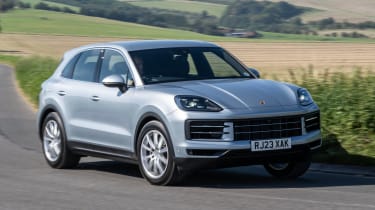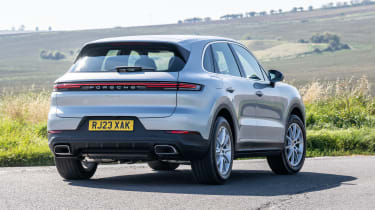Porsche Cayenne – ride and handling
The Cayenne feels taut and keen for a large SUV, but some rivals are more cosseting
In standard V6 form without rear-wheel steering, active anti-roll bars and air springs, the Cayenne doesn’t conjure the exceptional response and control we know this platform can achieve, but that isn’t to say its inherent dynamic ability doesn't rise to the surface.
Even without the chassis gizmos it feels intuitive and more reactive than similarly sized SUVs, with remnants of sporting DNA in its makeup. The clean, consistent steering feel allows you to trace a precise line along sweeping roads, with a measured rate of response as you wind on lock. The brakes are easy to modulate and picking a road apart feels natural, and while the Cayenne never completely shakes off its sense of size and weight, the forces at play feel expertly controlled.
This is partly due to the new damping technology, which (true to Porsche’s word) does offer a significant difference between each mode to suit the conditions. None of them feels overwrought – switching to Normal sets the car into a relaxed stride with an acceptable degree of vertical float, with Sport mode dialling this out for a more immediate, controlled reaction to bumps.
It’s a well-judged compromise, but even at its softest the Cayenne doesn’t feel quite as plush as other more overtly luxurious SUVs. There’s more road noise than you might expect and some poor surfaces do patter through the chassis, which is amplified in Sport mode.
The GTS, meanwhile, delivers the almost freakish supersaloon-on-stilts feel that the third-generation Cayenne is capable of. In its agility, throttle adjustability and steering precision it moves the game on massively from the base spec car without options, with a poise that few performance SUVs can match.
With the GT Package the Turbo E-Hybrid is a formidable performer, combining this dynamic strength with a monstrous 729bhp kick from its electrified V8. It feels like a heavy-set machine, but the sophisticated chassis tech makes it grippy and responsive to your inputs, and even throttle adjustable on the way out of corners. It's not especially plush and doesn't float along with the grace of a Range Rover, but it feels remarkably keyed into the road for an SUV.




